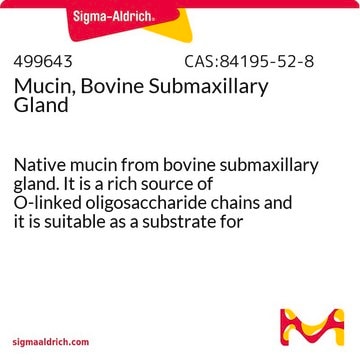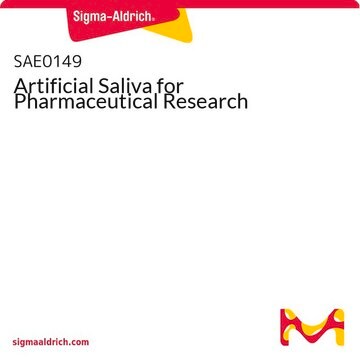M3895
Mucin from bovine submaxillary glands
Type I-S
Sinónimos:
MUC
About This Item
Productos recomendados
biological source
bovine submaxillary glands
type
Type I-S
form
powder
composition
Bound sialic acids, 9-24%
technique(s)
electrophoresis: suitable
UniProt accession no.
storage temp.
−20°C
Gene Information
cow ... BSM(286841)
¿Está buscando productos similares? Visita Guía de comparación de productos
Categorías relacionadas
General description
Application
- in the quantification of mucin
- as a component of artificial tear solution
- as a substrate for recombinant sialidase Gardnerella vaginalis
- to investigate a galactose-specific lectin from the red marine alga Ptilota filicina
- to study the characterization of a unique mucin-like glycoprotein secreted by a human endometrial adenocarcinoma cell line (Ishikawa)
Biochem/physiol Actions
Linkage
Substrates
Storage Class
11 - Combustible Solids
wgk_germany
WGK 3
flash_point_f
Not applicable
flash_point_c
Not applicable
ppe
Eyeshields, Gloves, type N95 (US)
Certificados de análisis (COA)
Busque Certificados de análisis (COA) introduciendo el número de lote del producto. Los números de lote se encuentran en la etiqueta del producto después de las palabras «Lot» o «Batch»
¿Ya tiene este producto?
Encuentre la documentación para los productos que ha comprado recientemente en la Biblioteca de documentos.
Los clientes también vieron
Artículos
Understand sialic acid structure, function, signaling, and modifications. Easily find products for sialic acid research.
Understand sialic acid structure, function, signaling, and modifications. Easily find products for sialic acid research.
Understand sialic acid structure, function, signaling, and modifications. Easily find products for sialic acid research.
Understand sialic acid structure, function, signaling, and modifications. Easily find products for sialic acid research.
Nuestro equipo de científicos tiene experiencia en todas las áreas de investigación: Ciencias de la vida, Ciencia de los materiales, Síntesis química, Cromatografía, Analítica y muchas otras.
Póngase en contacto con el Servicio técnico













